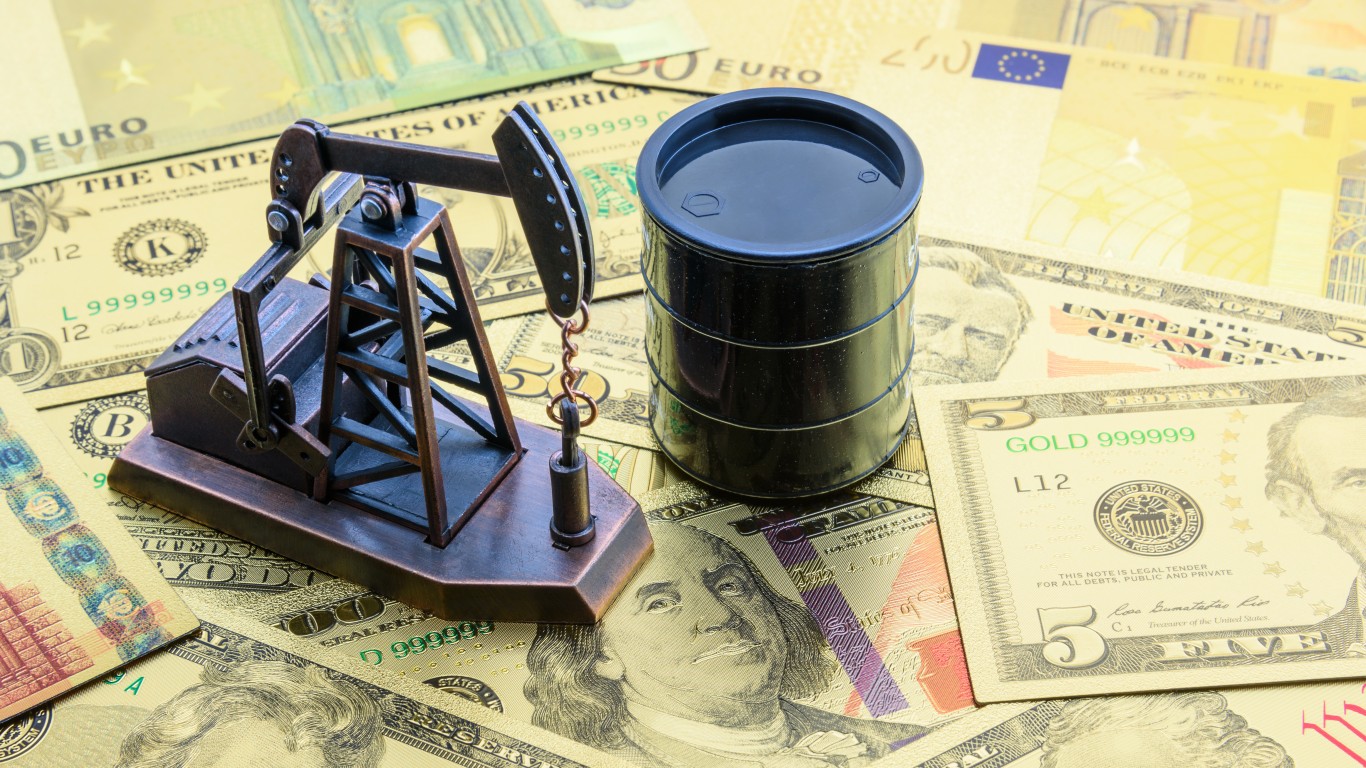
Energy stocks have taken a severe lashing this year. For the year to date, the energy sector has dropped by around 36% as the COVID-19 pandemic has kept drivers off the world’s roads and passenger jets out of the world’s airspace. Reduced production from the OPEC+ group of producer nations has also played a role in reducing the glut in crude inventories.
While the pandemic is primarily responsible for the sharp drop in demand for transportation fuel, investor enthusiasm is soaring for vehicles and technologies that do not use fossil fuels. Just as Tesla’s market cap is larger than that of the next seven largest automakers combined, the electric vehicle maker’s market cap is larger than the combined market cap of Chevron, Shell, Total, PetroChina and Petrobras, the second through sixth largest oil and gas companies. Saudi Aramco’s $2.1 trillion market cap is in a league of its own.
The good news for oil and gas producers is that prices are forecast to rise next year. According to the U.S. Energy Information Administration’s (EIA) December update to its Short-Term Energy Outlook, Brent crude (the international benchmark) is expected to end the year at around $41 a barrel, while West Texas Intermediate (WTI ), the U.S. benchmark, is tabbed to close 2020 at around $39 a barrel. The EIA’s forecast for 2021 calls for Brent to average $49 a barrel and WTI to average $46 a barrel. For the fourth quarter of next year, the EIA is forecasting Brent to rise to $50 a barrel.
Remember, 2019 was not a great year for oil either. WTI closed 2018 at around $65 a barrel, and the price at the end of the year had dropped to $57.
As prices rise now on hopes for an improved economy, oil and gas companies will be looking for opportunities in 2021 to meet the goals they had set for 2020. Those goals include reducing capital spending and improving returns to investors.
One big difference between 2020 and 2019 has been the number of announced mergers. The big deal in 2019 was Occidental’s $38 billion cash-and-stock acquisition of Anadarko. There were no deals of that size in 2020, but some large companies found partners willing to accept stock instead of cash and several deals got done.
Here’s a look at the buyers in the five big oil and gas deals that have been announced since July. Investors will be closely watching for a positive effect from expected higher crude prices on these stocks’ dividend yields.
Chevron Corp. (NYSE: CVX) paid $5 billion in an all-stock deal in July to acquire Noble Energy. This deal set the tone for all the transactions that followed: no cash, low premiums and bargain prices for assets. At a median price target of $101.50, Chevron’s potential upside at its current share price of around $85 is 20%. The stock trades at multiples of 29.5 and 16.4 to estimated earnings in 2021 and 2022, respectively. Chevron pays a dividend yield of 5.99%.
Devon Energy Corp. (NYSE: DVN) paid about $2.6 billion in stock for WRX Energy in September. Devon paid a premium of just 2.6% for WRX. The stock’s potential upside at a median price target of $18 and a current price of around $15 is 19.4%. The stock trades at multiples of 25.1 and 11.9 to estimated earnings in 2021 and 2022, respectively. Devon’s dividend yield is 2.97%.
In October, ConocoPhillips (NYSE: COP) splashed out $9.7 billion in stock for Concho Resources. Conoco paid a premium of 15% for Concho but paid about double the price paid by either Conoco or Chevron per barrel of proved reserves. At a current price of around $40 and a median price target of $50, Conoco’s potential upside is around 26%. The stock trades at multiples of 53.9 and 22.0 to estimated earnings in 2021 and 2022, respectively. ConocoPhillips pays a dividend yield of 4.41%.
Just a few days after the Conoco-Concho deal was announced, Pioneer Natural Resources Co. (NYSE: PXD) agreed to pay $4.5 billion in stock for Parsley Energy. Pioneer paid a premium of 7.9% for the stock and even more per proved barrel than Conoco had paid for Concho. Pioneer has a potential upside of 18.9%, with a price target of $130 and a current share price of around $110. The stock trades at multiples of 20.5 and 13.6 to estimated earnings in 2021 and 2022, respectively. Pioneer’s dividend yield is 2.03%.
On Monday, Diamondback Energy Inc. (NASDAQ: FANG) paid $2.2 billion in stock to acquire QEP, much to the dismay of investors in both companies. At the end of 2019, QEP reported proved reserves of 382.3 million barrels of oil equivalent, or less than $6 per proved barrel, much closer to the price Chevron and Devon paid for their added assets. Diamondback’s potential upside of around 25.3% is based on a recent share price of around $44 and estimated earnings multiples of 11.6 and 8.2 for 2021 and 2022, respectively. The QEP acquisition probably has not yet been included in the earnings estimates. Diamondback pays a dividend yield of 3.27%.
Are You Still Paying With a Debit Card?
The average American spends $17,274 on debit cards a year, and it’s a HUGE mistake. First, debit cards don’t have the same fraud protections as credit cards. Once your money is gone, it’s gone. But more importantly you can actually get something back from this spending every time you swipe.
Issuers are handing out wild bonuses right now. With some you can earn up to 5% back on every purchase. That’s like getting a 5% discount on everything you buy!
Our top pick is kind of hard to imagine. Not only does it pay up to 5% back, it also includes a $200 cash back reward in the first six months, a 0% intro APR, and…. $0 annual fee. It’s quite literally free money for any one that uses a card regularly. Click here to learn more!
Flywheel Publishing has partnered with CardRatings to provide coverage of credit card products. Flywheel Publishing and CardRatings may receive a commission from card issuers.
Thank you for reading! Have some feedback for us?
Contact the 24/7 Wall St. editorial team.
 24/7 Wall St.
24/7 Wall St.



